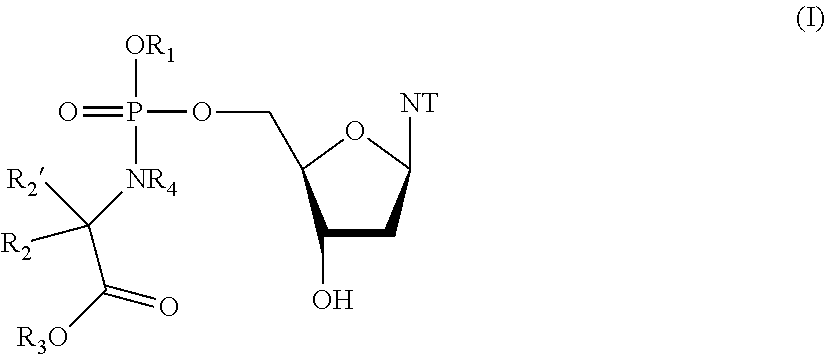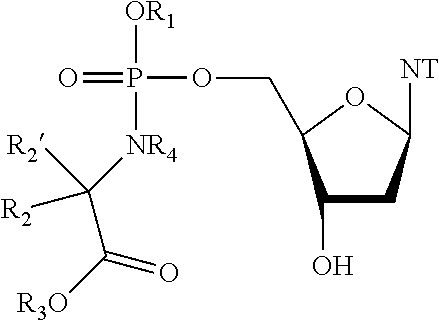Nucleic acid prodrugs
a technology of nucleic acid and prodrugs, applied in the field of nucleic acid prodrugs, can solve the problems of inability to address deficiencies by itself, low pharmacological prospects of nucleosides, dndps and dndps as practical treatments for mds in humans
- Summary
- Abstract
- Description
- Claims
- Application Information
AI Technical Summary
Benefits of technology
Problems solved by technology
Method used
Image
Examples
example 1
Protocols (Method D)
[0159]
General Procedure for the Preparation of Compound 14 benzyl ((((R,3S,5R)-5-(2-amino-6-oxo-1,6-dihydro-9H-purin-9-yl)-3-hydroxytetrahydrofuran-2-yOmethoxy)(naphthalen-1-yloxy)phosphoryl)-L-alaninate
[0160]A solution of compound 1024 (10.0 g, 46.5 mmol, 1.0 eq), compound 1021 (33.8 g, 93 mmol, 2.0 eq) and TEA (13.5 mL, 97.7 mmol, 2.1 eq) in DCM (120 mL) was stirred at 0° C. The mixture was warmed to rt and stirred for 2 h. The reaction was monitored by LCMS. The resulting mixture was quenched with water (250 mL). The organic layer was separated, dried over Na2SO4, filtered, and concentrated under reduced pressure. The crude product was purified by flash chromatography on silica (Et2O / EtOAc=2 / 1) to give compound 1025 (14 g, 59%) as colorless oil.
[0161]To a solution of compound 1025 (5.0 g, 9.88 mmol, 1.0 eq) in THF (15 mL) and NMP (60 mL) at 0° C. was added 1.0 M t-BuMgCl (14.8 mL, 14.8 mmol, 1.5 eq). The mixture was stirred at 0° C. for 0.5 h and a solution of...
example 2
11.0) Assay and Caco-2 Permeability Assay
[0162]The Log P assay was performed according to a miniaturized 1-octanol / buffer shake flask method followed by LC / MS / MS analysis. Test compounds were prepared as 10 mM solutions dissolved in 100% DMSO. Test compounds (10 mM in DMSO; 2 μL / well) and QC samples (10 mM in DMSO; 2 μL / well) were transferred in duplicate from storage tubes to the 96-well polypropylene cluster tubes. Buffer was prepared as 80 mM phosphate, 80 mM borate, and 80 mM acetate solution at pH 11.0 with 1% DMSO. Buffer-saturated 1-octanol (149 μL / well) and 1-octanol saturated buffer (149 μL / well) were added to each well. Each of the tubes was vigorously mixed on their sides for 3 minutes and then shaken upright for 1 hour at a speed of 880 rpm at room temperature. The tubes were centrifuged at 2500 rpm for 2 minutes. The buffer layer sample was diluted by a factor of 20 and the 1-octanol layer was diluted by a factor of 200 with internal standard solution. Sample analysis w...
example 3
rugs Rescue mtDNA Depletion in Patient-Derived Fibroblasts with DGUOK Deficiency.
[0167]Patient-derived fibroblast cell line 10028 containing a DGUOK splicing variant c.592-4_c.592-3delTT and a c.677A>G (p.H226R) resulting in a severe neonatal onset hepatocerebral presentation and mtDNA depletion was used, as described in Buchaklian et. al., Molecular Genetics and Metabolism, 2012, 107, 92-94. Cells were cultured in 3.5-cm diameter plates containing aMEM with 10% FBS plus 20 mM L-glutamine. Once confluent, cells were supplemented with serum-starved aMEM plus 20 mM L-glutamine. Compounds were dissolved in DMSO vehicle and added to media containing cells to give a final concentration between 1 and 100 uM. Control cells were supplemented with vehicle only. Cells were incubated with compound or vehicle for 10 consecutive days in serum-starved media, which was exchanged daily with identical media containing freshly prepared compound or vehicle. mtDNA copy number was assessed via qPCR as d...
PUM
 Login to View More
Login to View More Abstract
Description
Claims
Application Information
 Login to View More
Login to View More - Generate Ideas
- Intellectual Property
- Life Sciences
- Materials
- Tech Scout
- Unparalleled Data Quality
- Higher Quality Content
- 60% Fewer Hallucinations
Browse by: Latest US Patents, China's latest patents, Technical Efficacy Thesaurus, Application Domain, Technology Topic, Popular Technical Reports.
© 2025 PatSnap. All rights reserved.Legal|Privacy policy|Modern Slavery Act Transparency Statement|Sitemap|About US| Contact US: help@patsnap.com



